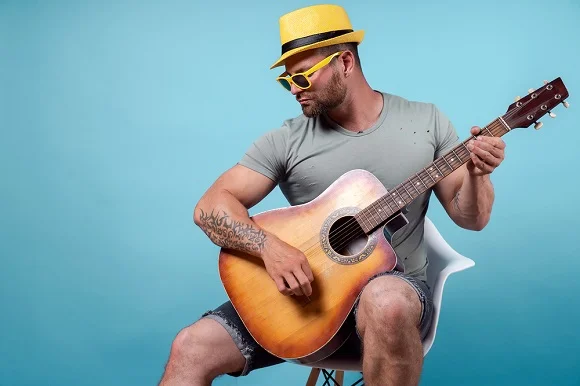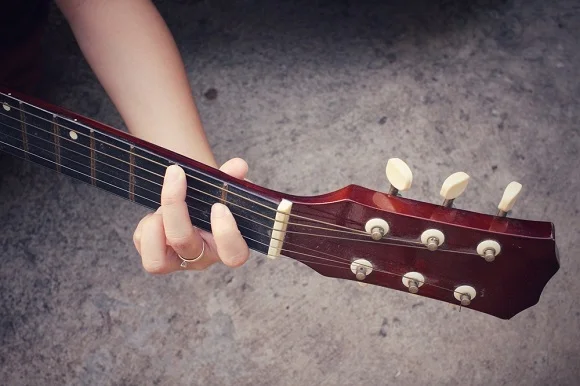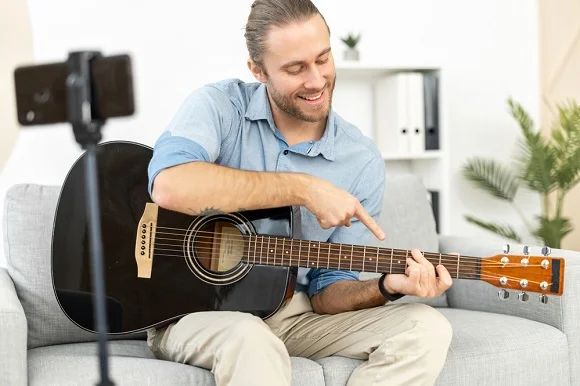The best way to catch a good piece of a fastball or approach your golf swing is to pick up the club or bat, and do whatever’s comfortable for you, said no coach ever.
Rarely is the most comfortable way of doing something also the most effective; To become great at anything, you need to learn the proper techniques and practice them until eventually, they become comfortable.
Proper posture and finger position are as crucial to learning guitar as the mechanics of a proper swing are to learning to hit a golf ball or baseball.
Following is all you’ll need to know about how to hold a guitar correctly. Keep in mind that all descriptions are intended for right-handed guitarists; for the left-handed position alternatives, simply reverse the instructions.
What’s The Proper Way To Hold A Guitar While Sitting?
The short answer to this question is that there are two “proper” ways to hold your guitar while playing or practicing in a seated position: the casual and the classical seated positions. We’ll describe both in detail in the next section.
More important, perhaps, than the “proper” way to hold a guitar while in a sitting position is how NOT to hold your guitar. The casual and the classical guitar pose are, after all, rooted in avoiding bad posture and habits.
Firstly, the neck of the guitar should never need support from your fretting hand to stay in position. The fretting hand should always be free to move up and down the guitar’s fretboard, unencumbered by the need to support, even in part, the guitar’s neck.
Also, any seated playing position that causes you to slouch or bend should be avoided. Not only will such postures make practicing uncomfortable and therefore less desirable, but, over time, playing this way can lead to chronic neck and back problems.
Finally, you want your seated guitar practice to translate, as seamlessly as possible, to your standing playing. The last thing you want is to log hours of practice only to discover you’re now an advanced guitarist when seated but only intermediate level when playing standing up.
When practicing in either of the seated positions, remember to keep your back as straight as possible and to sit with both feet on the floor (if you practice using a footstool, we’ll address that too.) Use your torso and the top of your right arm/strumming arm (if you play right-handed) to stabilize the instrument.
The Casual Seated Position Vs The Classical Seated Position
As mentioned above, the two most popular variations of the proper seated guitar posture are the casual seated position and the classical seated position. Both positions allow for proper posture, both support the guitar’s body and stabilize its neck, and both translate, to varying degrees, to standing playing.
The Casual Seated Position

Walk into any guitar store, and you’re likely to find at least two or three prospective buyers sitting on stools playing guitars in the casual position. By far the more popular of the two seated guitar postures, the casual seated position is comfortable and offers, for the most part, ready access to the entire fretboard of the guitar.
To hold your guitar in the casual position, rest the acoustic or electric guitar on your right thigh and let the back rest against your abdomen or chest.
In the case of acoustic guitar, your right elbow should rest on the top part of the guitar body. It will work as a pivot for your forearm and wrist to strum the strings comfortably and provide support against leaning down the guitar toward the ground.
Also, keep the guitar neck in a horizontal position to the ground. If you practice using a footstool, it should be placed beneath your right foot.
The casual seated position has the benefit of being relatively comfortable and familiar, but there are a few drawbacks to using this seated posture. First, the guitar’s neck isn’t quite as stable as it is when using the classical seated posture. It may not seem like a big deal, but neck stability can significantly impact your practice and performance.
Another disadvantage to using the casual position exclusively is that it can be difficult to practice wide stretches. Unless you’ve been blessed with long, dextrous fingers, you’ll likely find those forefinger-to-pinky stretches hard to pull off.
Finally, practicing in the casual seated position requires approaching the guitar differently than you do while standing. Because of this, transitioning between seated practice to standing performance (or jamming) may require a little fine-tuning, so to speak.
The Classical Seated Position

When we first started playing guitar, most of us had no idea how to hold a guitar correctly. So, we imitated what we saw and adopted the casual postures of our friends and most of our guitar heroes. For the first few years I played guitar, I used the casual seated position simply because I didn’t know any better.
It wasn’t until I discovered Randy Rhoades that I was introduced to a more classically-driven guitar style and the classical seated position. Immediately I incorporated the classical guitar correct posture into my practice routines, and the gains I made were significant.
To practice in the classical seated position, rest your guitar on your left leg (thigh), using your right thigh to help stabilize the guitar body. As with the casual seated position, the instrument’s body will rest against your abdomen.
When using the classical seated position, the neck is angled upward. Having the guitar’s neck in line with the guitarist’s body makes the entire fretboard readily accessible and helps promote better guitar posture.
Another advantage to practicing in the classical seated position is that the neck of the guitar is significantly more stable than when held in the casual posture. As mentioned earlier, the less stabilization your guitar’s neck needs from your fretting hand, the better.
Also Read: For any kind of seated position, you need a special kind of perfect sitting arrangement that can provide ample comfort. To find out the suitable one for you, check our detailed article on the best type of chair & stool for guitar playing.
Left Hand (Fretting Hand) Placement
Proper guitar hand position when you hold a guitar is essential to good practice. The optimal placement of the left hand is to keep your wrist straight (or as straight as possible) with a minimum of an arch. The fingers of the left hand should be bent at all joints to about half their range of motion.
The thumb of the left hand should be relaxed and positioned on the back of the guitar’s neck.
Right Handed Guitar Position
As with the left-handed position, the right wrist should be held straight as possible. The right fingers should be bent to about half their range of motion at all joints. The wrist of the right hand should be angled, so the palm is parallel to the strings.
How To Hold Your Guitar’s Neck

While it’s important to touch on how to hold your guitar’s neck, I want to point out that “holding” isn’t exactly what we’re talking about. As we’ve discussed, your guitar’s neck should be relatively stable, thanks to your right arm. Instead, we’re talking about how to position your fretting hand on the neck.
Form a “C” with the thumb and forefinger of your fretting hand; the guitar neck will rest in this “C,” with your thumb on the back of the guitar’s neck and your fretting fingers positioned above the strings.
Keep your wrist relaxed, and don’t press too hard against the back of the guitar’s neck with your thumb. This will enable you to slide up and down the neck as necessary. Obviously, your thumb will move as you play but return to this “home position” whenever possible.
Finger Placement
Finger placement is essential to guitar playing and something with which most beginner guitarists struggle. It seems like it should be the easiest thing in the world, but sounding a note properly takes a little bit of work at first, and finger placement is the reason.

Here are a few tips if you’re struggling to finger your instrument correctly:
Curl Your Fingers
When playing a note, be sure to curl your finger so you can press down on the string with your fingertip and not the pad of your finger. Doing so will leave open strings unencumbered, allowing you to play better-sounding chords as you progress. Bending your fingers will also enable you to finger the note with adequate force.
Practice Fretboard Proximity
Many beginner guitarists struggle with a tendency to let unused fretting fingers relax in between notes. This is a bad habit that’s best to address quickly. When playing, practice keeping all of your fretting fingers as close to the fretboard as possible. Establishing this habit early on will make transitioning between notes and phrases far less challenging.
Finger Notes As Close To The Fret Marker As Possible
To get clear-sounding notes that ring out, be sure to always finger notes as close to the fret marker as you can without the note dulling or muting out. If, for example, you are playing a note on the third fret (between the second and third fret markers), finger the note as closely to the third fret marker as possible.
Practice “Rolling” Your Wrist
We noted earlier that, ideally, your thumb should be positioned on the back of the neck, approximately between the D and G strings. There are several reasons for this, including added power and stability.
When playing on the highest and lowest strings, you’ll want to “roll” your wrist to allow your fretting fingers some maneuvering room. When playing on the high E string, let your thumb slide lower on the back of the neck; move your thumb up when fingering notes on the low E. These movements will often come naturally if your thumb is positioned correctly, but it is good practice.
How To Hold A Guitar Properly While Standing

When using a guitar strap to play standing up, the guitar hangs in a position closely resembling the casual seated position, in that the neck is more or less perpendicular to the floor or angled slightly upward. Investing in a comfortable strap is essential, as long periods of standing position play can result in sore backs, shoulders, and necks.
Many famous rock guitarists take the casual thing to the next level, wearing their guitars extremely low; this may look cool, but it isn’t at all good practice. A good rule of thumb is to adjust your strap, so your guitar is as close to where it is situated during seated practice as possible.
Interestingly, some guitarists, Like Zakk Wylde, play standing with their guitar’s neck held perpendicular to the ground, mimicking a classical position.
Once you’ve become a bit more comfortable switching between seated and standing play, you’ll likely adjust your strap (guitar height) to your own personal preferences.
Frequently Asked Questions
Which Way Do You Hold The Guitar If Left-Handed?
If you play guitar left-handed, simply reverse the instructions given above. For example, in the classical position, a left-handed player would hold the guitar so it rests on their right thigh rather than the left.
Does Posture Affect Guitar Playing?
Proper posture when holding a guitar is extremely important; over time, poor posture can lead to chronic neck, shoulder, and back pain.
But does good posture actually improve your playing? It can, as better posture leads to more comfortable practicing, which allows you to practice longer and more often.
Is The Classical Position Better?
When it comes to how you hold a guitar, nobody can say with any certainty whether the classical or casual position is “better.” We touched on some of the advantages and disadvantages of each position above, but in the final tally, either position is good as long as you maintain proper posture.
Or maybe a better way to answer this is to say the classical position is better for practicing some things, while the casual is better for rehearsing others. Ultimately, how you decide to hold the guitar while practicing depends on what you’re practicing and how you feel most comfortable practicing it.
Do You Hold A Guitar With Your Dominant Hand?
The vast majority of guitarists will “hold” the guitar with their dominant hand. Of course, you aren’t actually holding the guitar as much as stabilizing it between your dominant-side thigh and upper arm.

